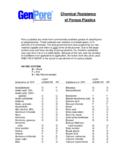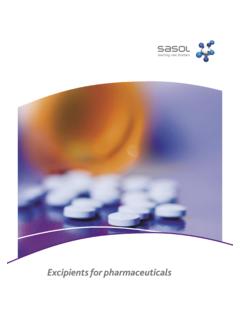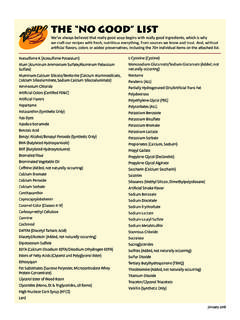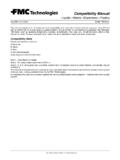Transcription of LUTEIN from TAGETES ERECTA - Food and Agriculture ...
1 LUTEIN from TAGETES ERECTA . New specifications prepared at the 63rd JECFA (2004) and published in FNP52 Add 12 (2004). A group ADI of 0 - 2 mg/kg bw for LUTEIN from T. ERECTA and synthetic zeaxanthin was established at the 63rd JECFA. (2004). SYNONYMS Vegetable LUTEIN ; vegetable luteol; Bo-Xan ( LUTEIN ). DEFINITION LUTEIN from TAGETES ERECTA L. is a purified extract of xanthophylls obtained from marigold oleoresin. The oleoresin is prepared from hexane extracts of marigold ( TAGETES ERECTA L) flowers, saponified with potassium hydroxide in either methanol or propylene glycol. The resulting crystalline material contains LUTEIN , and minor components including other carotenoids and waxes. Chemical names 3R,3'R,6'R- , -carotene-3,3'-diol; all-trans- LUTEIN ; 4',5'-didehydro-5',6'- dihydro-beta,beta-carotene-3,3'-diol ( LUTEIN ).
2 Number 127-40-2 ( LUTEIN ). Chemical formula C40H56O2 ( LUTEIN ). Structural formula Formula weight ( LUTEIN ). Assay Not less than 80 % total carotenoids, not less than 70 % LUTEIN DESCRIPTION A free-flowing, orange-red powder FUNCTIONAL USES Colour, nutrient supplement CHARACTERISTICS. IDENTIFICATION. Solubility (Vol. 4) Insoluble in water, soluble in hexane Spectrophotometry A chloroform/ethanol (1:9) solution shows maximum absorbance at ca. (Vol. 4) 445 nm Melting range (Vol. 4) 177 to 178 . Test for carotenoids The colour of a solution of the sample in acetone disappears after (Vol. 4) successive addition of a 5% solution of sodium nitrite and M of sulfuric acid. PURITY. Moisture (Vol. 4) Not more than Ash (Vol.)
3 4) Not more than Zeaxanthin Not more than See description under METHOD OF ASSAY. Lead (Vol. 4) Not more than 3 mg/kg. Determine using an atomic absorption technique appropriate to the specified level. The selection of sample size and method of sample preparation may be based on the principles of the methods described in Volume 4, "Instrumental Methods". Hexane (Vol. 4) Not more than 50 mg/kg Methanol (Vol. 4) Not more than 10 mg/kg Propylene glycol Not more than 1000 mg/kg Test as described for Sucrose Esters of Fatty Acids (FNP 52 Add 11 p 76). Waxes Not more than See description under TESTS. TESTS. PURITY TESTS. Waxes Determine by gas chromatography using the following conditions: Apparatus GC equipped with an autosampler, a splitless injection system, flame ionization detector (FID), programmable column and detector flow rates.
4 GC column DB5, 30 m x mm ID with a m film thickness. GC injector temperature: 280 . FID temperature: 300 . GC column initialtemperature: 50 (held for 2 min). GC oven temperature increase rate: 13 /min GC column final temperature:300 (held for 8 min). Carrier gas (Helium) flow rate: ml/min Injection mode: splitless Approximate run time: 30 min Internal standard pentacosane (C25). Calibration standards are prepared through the addition of absolute hydrocarbon standards to methylene chloride to provide hydrocarbon concentrations of , 10, 25, 50, 75, and 100 mg/kg. Sample Preparation Accurately weigh 200 mg of sample into a centrifuge tube and dissolve in exactly 20 ml of methylene chloride. Sonication or vortex mixing may be required to completely dissolve the product.
5 Centrifuge sample at 2500 rpm for 5 min if the sample appears turbid. Transfer 40 l into 2 ml autosampler vial that contains ml of methylene chloride and 20 l of (5000 mg/kg) pentacosane for a final concentration of 50 mg/kg. Sample Analysis Autosampler injects a l aliquot of the solution onto the GC. column. Results The approximate retention according to GC/FID times of nonacosane (C29), triacontane (C30), henitriacontane (C31), C32, triatriacontaine (C33), C34, C35, and the internal standard pentacosane (C25) are , , , , , , , and minutes, respectively. METHOD OF Determine the total carotenoid content and the content of LUTEIN and ASSAY zeaxanthin by HPLC using the following conditions: Reagents: Hexane (HPLC grade).
6 Ethyl acetate (HPLC grade). Ethyl alcohol Toluene Solvent Mixture: (10:6:7:7 hexane:ethanol:acetone:toluene v/v/v/v). Standard Solution: Weigh accurately about 1g LUTEIN and transfer into 100 ml amber volumetric flask and dilute to mark with the Solvent Mixture. Apparatus UV/vis spectrophotometer HPLC system with suitable diode array detector, autosampler, column oven, signal processor and degasser. Analytical column: 3 m silica, mm x 250 mm. Instrument Conditions Oven temperature: ambient Mobile Phase: 70:30 (v:v) hexane/ethyl acetate (isocratic elution). Flow Rate: ml/min Injection: 10 l Detection: performed at 446 nm Run Time: approximately 40 min Sample Preparation: Weigh sample (range 27 to 33 mg) into a glass weighing funnel, wash crystals with the Solvent Mixture into a 100 ml volumetric flask, dilute to the mark and stir for 10 min.
7 Pipette 1 ml from flask into a second 100 ml volumetric flask, dilute to the mark with ethanol, mix by inversion for 20 seconds. Read samples in a spectrophotometer at 446 nm. For HPLC, dry the samples down using nitrogen steam, dissolve solids in 70:30 hexane:ethyl acetate, add ml to HPLC vials and measure at 446 nm. Results The retention times for LUTEIN and zeaxanthin are approximately and min, respectively. The resolution between the HPLC peaks for LUTEIN and xeazanthin ranged from to Calculation Absorbance at 446 nm x 10000. Total carotenoids (%) =. sample mass in g x 2550. Note: The factors 10000 and 2550 are the dilution factor and extinction value for a 1% solution, respectively. LUTEIN (%) = total carotenoids x area % LUTEIN Zeaxanthin (%) = total carotenoids x area % zeaxanthi


















